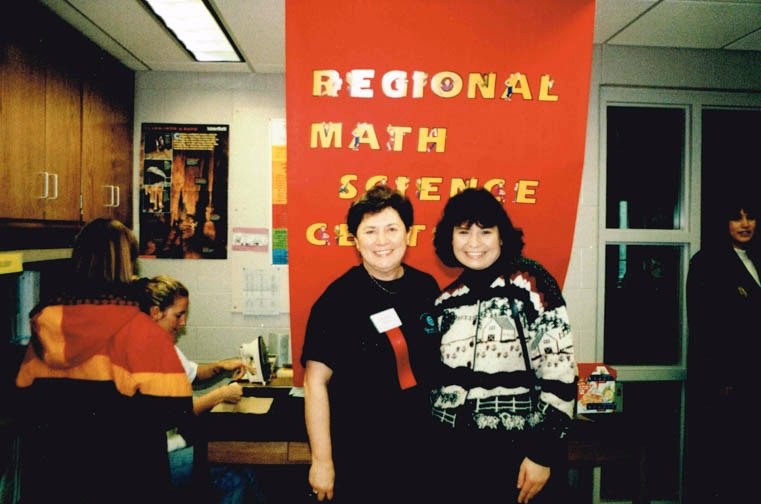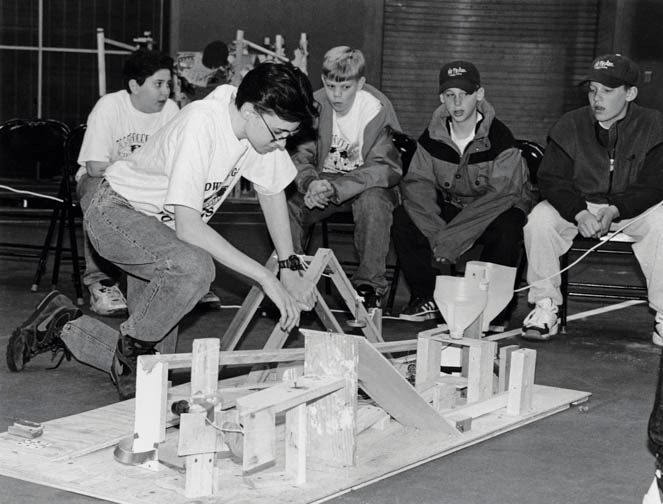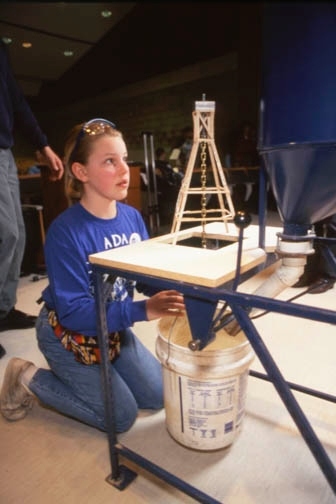Regional Math and Science Center
Celebrating 25 years of providing K-12 programs, resources
by Matthew Makowski
Grand Valley’s Regional Math and Science Center developed from a growing need in West Michigan for excitement, engagement and additional resources in science and mathematics K-12 education 25 years ago. The center now provides such resources and programs to about 6,000 students and more than 600 teachers in 42 school districts in Kent, Ottawa and Montcalm counties each year.
While the center’s success continues to grow, it blossomed from humble beginnings.
In recent years, the RMSC has developed multiple new programs such as Super Science Saturday, G3 Camp, Math-Team-Matics and sHaPe Camp, but it was the annual Science Olympiad Tournament that acted as the starting point for the success of the center’s initiatives.
Science Olympiad
Mary Ann Sheline, RMSC director emerita, said in the early 1980s during the university’s initial push to provide resources in K-12 science and mathematics, Grand Valley’s Science and Mathematics Division only sponsored an open house science day, several “calculator and computer competitions” and coordinated student visits and tours of the Allendale Campus.
“There was no formal scheduling procedure so teachers connected with their favorite professors or departments to arrange for student visits and campus tours,” Sheline said.

At left, Mary Ann Sheline, Regional Math and Science Center director emerita, greets Pam Showalter, a former student employee, at the 1996 Padnos Hall Open House. The event celebrated the opening of the Padnos Hall of Science.
In 1983, the division attempted to bring more organization to its efforts with the introduction of the Science Olympiad Tournament, which now brings hundreds of middle and high school students to the Allendale Campus each year to compete in a series of team-based interscholastic competitions in biology, earth science, chemistry, physics and technology.
At that time, Michigan became one of only two states in the U.S. to hold a Science Olympiad competition. Science Olympiad is an international nonprofit organization devoted to improving the quality of science education by increasing student interest and providing recognition for outstanding achievements in science education by both students and teachers.
Doug Kindschi, former dean of the Science and Mathematics Division, capitalized on this new event in 1984 by hiring Sheline to coordinate and organize the event to be hosted by Grand Valley. It was a decision, Kindschi said, was one of his greatest accomplishments while working with the RMSC in its earlier years.
“Mary Ann had the skills to lead the Science Olympiad Tournament because of her experience teaching at the high school level,” said Kindschi. “Her talent of working with people, be they college faculty, high school teachers or students, led to successful tournaments year after year.”
Once on board, Sheline said she knew it would take a large group effort to create a successful tournament at Grand Valley.
“There were many unknowns as it was a fledging program nationwide and a first-time event for Grand Valley as well,” said Sheline. “We needed to communicate with schools and encourage them to participate. The concept was very engaging and people, both at GVSU and in area secondary schools, were willing to give it a try.”
During the university’s first Region 12 Science Olympiad Tournament, 26 teams competed from schools in Kent, Ottawa, Muskegon, Allegan and Oceana counties. Today the tournament sees approximately 70 participating teams and acts as a way to bring young students to the university for a fun and educational experience.

Students test their ‘Mission Possible’ device during the 1994 Region 12 Michigan Science Olympiad Tournament.
The Science Olympiad has had lasting effects on many former participants. Missy Sculley, a former Science Olympiad participant turned coach, said she remembers how exciting it was to apply knowledge she learned in the classroom in a different setting while competing against students from other schools.
“As a group of students we dreamed up solutions to the different events and then got exposed to other schools and what they dreamed,” Scully said. “It also opened up the world of science and all its different specialties.”
Currently, Scully is a Science Olympiad coach at Byron Center Christian Middle School and said she values being able to her help students receive an experience similar to what she had while competing.
“They get to create, design, build and test things. They get to be a part of a team and work in partnership in solving problems and seeking the answers to questions. They get to have fun discovering stuff about the world around them and about themselves,” Scully said.
Fall Science Update Seminar
The success of Science Olympiad led to the creation of the Science and Math Update Seminar in 1986. The seminar is a regional professional development and networking conference during which science and mathematics teachers are provided timely information and resources that can be used in the classroom.
The seminar evolved to now be known as the Fall Science Update. The Mathematics Department has since created the “Math in Action” program that fills the needs of mathematics teachers in West Michigan.
Shortly after the seminar came to fruition, the Coalition for Excellence in Science and Mathematics was established in 1987. It coordinated the efforts of science and mathematics educators and worked to connect the K-16 community to businesses and formal science groups, like museums and zoos, among others.
State funding
With Grand Valley’s strong commitment to outreach activities in science and mathematics, and professors giving their time and expertise to interact with K-12 students and teachers, the Science and Math Education Center was established in the 1990-1991 academic year.
Sheline said the three primary goals of the outreach center were to serve as a catalyst in the evaluation and improvement of curriculum; improve the scholastic practices of university faculty and K-12 teachers; and sponsor and coordinate a variety of activities that would engage students’ interests in mathematics and science.

While working with the coalition, Howard Stein, late biology professor at Grand Valley and former president of the Michigan Science Teachers Association, served as director of the center as it continued to sponsor the Science Olympiad, Fall Science Update Seminars, workshops and other various science programs.
Around the same time, the state of Michigan began funding regional mathematics and science centers to promote high quality science and mathematics instruction through leadership, professional development, student programs and curriculum and resource development.
In 1988, 20 centers were established and funded by Michigan’s Legislature, but none were in West Michigan. In 1994, funding was provided for a center at Grand Valley. It was then decided to merge the efforts of the Coalition for Excellence in Science and Mathematics Education and the Grand Valley Science and Math Education Center into the current Regional Math and Science Center.
RMSC
Super Science Saturday: provides K-12 students with an educational experience through hands-on scientific investigation, while showing them the appeal of science, mathematics and the arts.
Grandparents, Grandkids, Grand Valley (G3) Camp: is an opportunity for children ages 8-12 and their grandparents to live, learn and laugh on the Allendale Campus through a variety
of hands-on sessions designed for all ages.
Math-Team-Matics: Approximately 100 middle and high school students put their mathematical knowledge to the test as they compete against each other in four contests involving content from K-8 mathematics as well as high school algebra and geometry.
InterChange Newsletter: The RMSC newsletter, both print and digital, helps bring resources and information about science and mathematics to the K-12 community.
STEM Kits: are comprised of mathematics, science and engineering information and activities designed to incorporate real world concepts that pique students’ interests and critical thinking skills. During the 2013-2014 school year, STEM Kits were loaned to approximately 19 schools and organizations serving more than 3,000 students.
Summer Health Activities and Professions Exploration (sHaPe) Camp: is an annual summer day camp for area middle school students. The camp exposes them to various health professions with the goal of encouraging students to pursue STEM fields and earn additional training after high school graduation.
With full funding from the Legislature, RMSC became one of 33 similar centers that comprise the Michigan Mathematics and Science Center Network. Now, the center is a part of the College of Liberal Arts and Sciences under the leadership of Karen Meyers, who became the center’s director in 2008.
Meyers said with strong and continuous support from the Grand Valley community, the future of the RMSC is well-positioned to meet the growing needs of the region in STEM-focused education.
